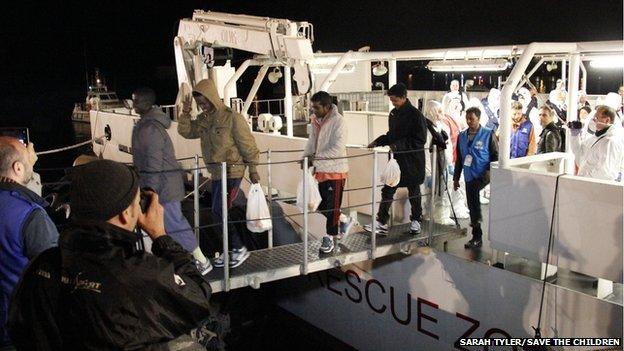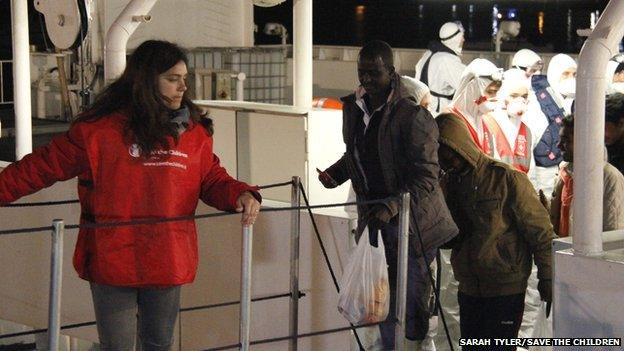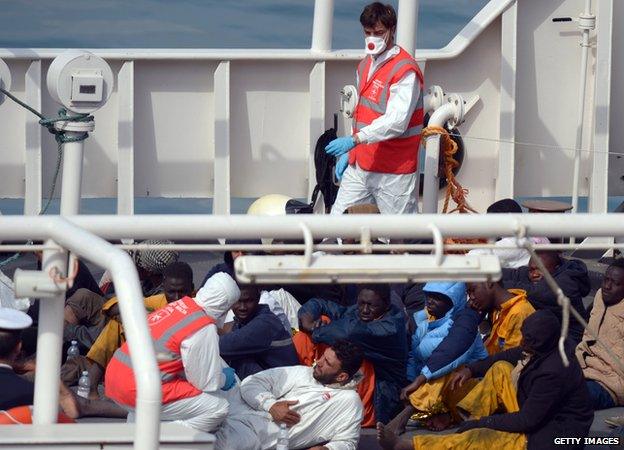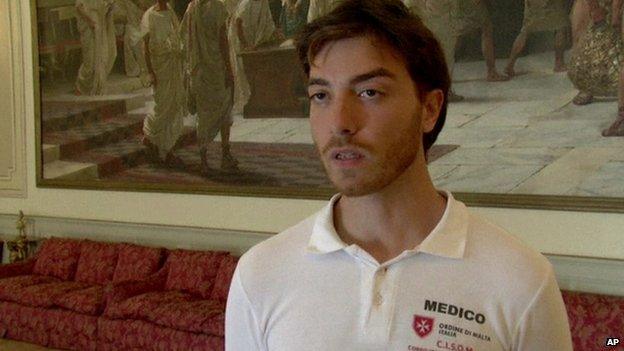Mediterranean migrants crisis: What happened on the sinking boat?
- Published

Only 28 people survived when a trawler carrying more than 800 people sank
More details have emerged of the conditions in which hundreds of migrants were kept in the days before their boat sank, killing up to 800 people.
The three-deck fishing boat carrying migrants from Libya sank on Sunday after crashing into a merchant rescue ship, in what the UN has called the deadliest incident in the Mediterranean ever recorded.
Only 28 people survived - four were children.
Italian prosecutors say the migrants paid between $700 (£466) and $7,000 (£4,665) to be on board, having been forced to stay on a farm in Libya for up to a month before the journey.
While there, prosecutors say, the migrants were subject to abuse and there are reports of deaths due to violence and exhaustion.
One boy who boarded a dinghy early was killed by the smugglers and thrown overboard.
Two boys rescued from the boat, aged 16 to 17, recall hearing screams from people locked in the hold below.

Somali 'beaten to get on board'
Said, 16, from Somalia, told Save the Children he heard the smugglers say they would try to get 1,200 people on the ill-fated trawler and people were beaten to board it.
His parents - who have eight other children - handed him over to Sudanese traffickers last summer in the hope he could join relatives in Norway.
He was held prisoner by armed smugglers for nine months at the Libyan border, while his parents raised the money to pay for his journey.

The four children who survived are in a reception centre in Sicily
He said he saw other children there die from sickness and starvation.
He was taken in a rubber dinghy to the fishing boat and beaten by the smugglers to get on board.
"They stopped at 800 because it was full. We couldn't even move. There was no food or water. The people that were put below were locked underneath."
He said the smugglers raised a call for help after the boat ran into trouble. When people saw the lights of the rescue boats everyone began to move to one side and the boat inclined until it turned over completely, he recalled.

Teens swimming for survival
Bangladeshi teenager Abdirizzak said there were three classes of passengers and those who had the least money were stuffed into the hold of the boat and locked inside.
He told Italian newspaper Corriere della Sera: "We were on the middle level and only those who paid more were above."
He described the moment the collision happened in pitch darkness.
"Everyone was screaming, pushing, punching, elbowing - terrified. From below we could hear those who were locked in shouting 'Help, Help!'

Survivors said many of the people on board the trawler could not swim
"I don't know how but somehow we managed to swim outside just in time before the boat went down."
Another Bangladeshi survivor Riajul, 17, told the Daily Telegraph: "People panicked - they all ran to the other side of the deck. That's what tipped us over.
"Most of the other migrants were African and they didn't know how to swim. I did and that's why I survived," he said.

The boy saved by a bin
Nassir, 17, from Bangladesh told Corriere paying $900 (£598, €836) for a seat on the deck saved his life.
He said: "We were about 30, no more. The others were all inside, closed."
"We raced to the bow and the boat sank in five minutes," he said describing the moment the trawler crashed.
He managed to survive by clinging to a bin.
"I heard the cries for help of those who had been locked in the hold. We were at sea half an hour before the merchant lowered a rope and saved us," he said.

The rescuers' story
One of the medics, who arrived at the scene after the trawler had disappeared into the sea, said: "We found, literally, a floating cemetery. Bodies were everywhere.
"With the dinghies we had to literally slalom among the corpses,'' said Enrico Vitello, a 22-year-old medic from the Order of Malta.

Giuseppe Pomilla said a boy exploded in tears at being saved
Hearing screams, they stopped the engines and shined a spotlight, spotting someone in the sea.
"We got close by and rescued him,'' said Giuseppe Pomilla, a 30-year-old medic. "He asked our names and where we were from. We told him we were Italians and came to rescue him. He was so happy.''
Soon after, a boy floating in the sea grabbed their attention.
"We couldn't understand if he was alive or dead. He had his eyes wide open looking at us. He was not blinking, not moving or talking. We only realized he was alive when he grabbed us suddenly,'' Mr Pomilla said.
When they took him on board, he "exploded in tears'', the medic said.